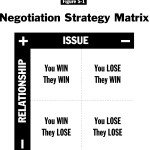Negotiation Tools, Techniques, and Tactics (T3) Part I

Robert Menard, Certified Purchasing Professional, Certified Professional Purchasing Consultant
Negotiation unfolds neither in a linear nor a necessarily logical fashion. Depending on their skills and experience, negotiators can and do jump in at any point, often with no strategy and a heavy handed reliance on tired tactics. These faux pas signal minimal to no preparation, little understanding of the process, and discomfort with one’s own skill levels in negotiation. Accordingly, pros must be prepared to play the game from any position.
Arts and Sciences
Think of negotiation as a mixture of arts and sciences, the process or mechanics are composed of two parts:
Preparation and planning 90% of the time investment
Face/face and voice/voice 10% of the time investment
The ten percent sliver can be overwhelming without ability and skill with Tools, Techniques, and Tactics. These are identified below to help us overcome that fear. First, we must recognize these two facts:
- Communication skills are the stage upon which negotiation is played out
- Tactics, although necessary, are inadequate for good negotiation outcomes
 There are four strategies, Win-Win, Win-Lose, Lose-Win, and Lose-Lose. All are appropriate depending upon the importance of the Issue and the Relationship. See Fig.5.1 at left
There are four strategies, Win-Win, Win-Lose, Lose-Win, and Lose-Lose. All are appropriate depending upon the importance of the Issue and the Relationship. See Fig.5.1 at left
Given the emphasis on strategic Sourcing and Preferred Suppliers, manifested most often in Single and Sole sources, most of our negotiations will fall into the Win-Win quadrant, even if we may need to educate some of our suppliers to this fact from time to time. Partnering is a refined form of Win-Win strategy. It succeeds as the parties focus on cost reduction as the motivating rationale for doing business.
Tools
We may not have thought of these familiar practices as negotiation tools. Apply them frequently and think of every workplace challenge as a negotiation opportunity. The overarching and unifying concept is Total Cost of Ownership (TCO). TCO is the sum of its four elements. Simply stated, the lowest TCO is the Best Value
TCO = Quality + Service + Delivery + Price
Our constant obligation is to think in terms of TCO. To do, create a mini-negotiation plan by identifying and ranking cost drivers Once the costs have been identified and ranked, we establish a concession strategy, the engine of negotiation. The pistons of the engine are these tools:
High Initial Demand
Nice to have
Must have
We must also estimate these three positions of the other side and keep these tools in constant use:
 Price Analysis
Price Analysis- Cost Analysis
- Supplier Management tools
- Certification
- RFQ/RFQ evaluation
- Performance evaluation
- Score Cards
- Supplier Corrective Action Reports (SCAR)
- Continuous Improvement plans
To be continued in Part II…
For your copy of the book, You’re the Buyer – You Negotiate It, or CD sets, please visit this site.